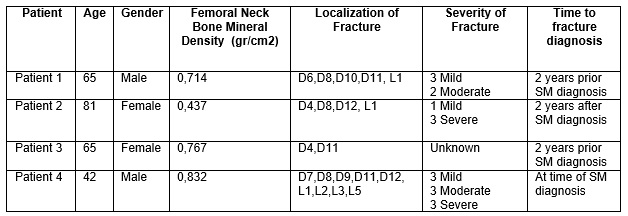Session Information
Date: Monday, November 8, 2021
Title: Osteoporosis & Metabolic Bone Disease – Basic & Clinical Science Poster (1135–1149)
Session Type: Poster Session C
Session Time: 8:30AM-10:30AM
Background/Purpose: Systemic Mastocytosis (SM) is a very rare disease (0,5 -1 per 10000 in adults). Most common manifestations are skin related or anaphylaxis, however almost one third of patients may present with concomitant osteoporosis (OP) resulting in fragility fracture (FF) in around 5 -37% of patients. FF affect lumbar spine (LS) more frequently in young men. Alcohol consumption, high serum tryptase level, and low femoral T score have been described as risk factors but there are some discrepancies between studies. 1-2 Our primary objective was to identify factors associated with FF in patients with SM.
Methods: We analysed all consecutive patients attending a multidisciplinary clinic up to April 2021. This clinic has been recently established by experts from Allergy and Rheumatology departments at our Centre, patients with SM diagnosis according to the 2001 WHO criteria are included. We collected demographic data, general risk factors for OP, and clinical characteristics including cutaneous involvement, bone involvement and laboratory data as serum tryptase level. Bone involvement is defined as densitometric OP (T score < – 2.5) or FF. Normally distributed variables are described as means (SD) and dichotomous variables as number and frequencies. Comparison between patients with and without FF is performed using t-test and Chi2 when needed.
Results: Seventeen patients with SM are included in this preliminary analysis. Four patients (24%) presented a FF, all of them vertebral fractures identified by plain radiographies (most of them multiple, located in dorsal vertebrae). Two men and two women presented FF, they were older versus patients without FF (Table 1), and without general risk factors for OP, including alcohol consumption and tobacco use. All of them have a high basal serum tryptase and most of them presented other MS symptoms (cutaneous, anaphylaxia). FRAX tool was useful in only one patient to predict FF risk. The two men with FF diagnosis do not met criteria for densitometric OP, specific characteristics for these patients are presented in Table 2.
Conclusion: In our cohort of SM, about 25% of patients present FF, in most cases multiple, located in dorsal spine, and without densitometric diagnosis of OP. Our patients are older versus other population described previously in the literature. FRAX may underestimate the risk of FF in patients with SM. We could not identify variables associated to higher risk of FF in this group of patients. SM should always be considered in differential diagnosis in the presence of FF, especially in men with no OP or another risk factor associated.
 Table 1. Demographic data, risk associated factors, laboratory test, bone densitometry divided by patients with fragility fracture and patients without fragility fracture.
Table 1. Demographic data, risk associated factors, laboratory test, bone densitometry divided by patients with fragility fracture and patients without fragility fracture.
 Table 2. Characteristics of Fragility Fracture in four patients with Systemic Mastocytosis.
Table 2. Characteristics of Fragility Fracture in four patients with Systemic Mastocytosis.
To cite this abstract in AMA style:
Carpio Astudillo K, Skrabski F, CASTREJON I, Alvaro-Gracia J, Garcia Prieto A, González T. Factors Associated with Fragility Fracture in Patients with Systemic Mastocytosis: Data from an Inception Cohort in a Single Centre [abstract]. Arthritis Rheumatol. 2021; 73 (suppl 9). https://acrabstracts.org/abstract/factors-associated-with-fragility-fracture-in-patients-with-systemic-mastocytosis-data-from-an-inception-cohort-in-a-single-centre/. Accessed .« Back to ACR Convergence 2021
ACR Meeting Abstracts - https://acrabstracts.org/abstract/factors-associated-with-fragility-fracture-in-patients-with-systemic-mastocytosis-data-from-an-inception-cohort-in-a-single-centre/
